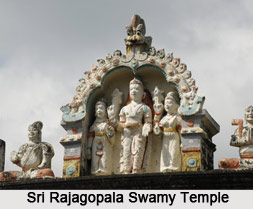 Sri Rajagopala Perumal Temple is a noteworthy Vishnu temple in Manimangalam, housing Lord Rajagopala Perumal. Manimangalam is a tiny village of great historic importance situated in the interior of Kanchipuram district, approximately twenty kilometers from Sriperumbudur. It is venerated as the birthplace (avatarasthala) of Sri Ramanuja. It is the home of two very ancient Vishnu temples which date back to the Chola times, or perhaps even earlier. However the historical researches made it clear that the temple is the traditional and antique in its form and existence.
Sri Rajagopala Perumal Temple is a noteworthy Vishnu temple in Manimangalam, housing Lord Rajagopala Perumal. Manimangalam is a tiny village of great historic importance situated in the interior of Kanchipuram district, approximately twenty kilometers from Sriperumbudur. It is venerated as the birthplace (avatarasthala) of Sri Ramanuja. It is the home of two very ancient Vishnu temples which date back to the Chola times, or perhaps even earlier. However the historical researches made it clear that the temple is the traditional and antique in its form and existence.
Image of Sri Rajagopala Perumal Temple, Manimangalam, South India
The image of Sri Rajagopala Perumal temple is the chief attraction of the temple. The presiding deity of the larger temple in Manimangalam is Sri Rajagopala Perumal, who is enshrined in the main sanctum facing east. The imposing image is immensely captivating and is seen in a standing posture. The deity is found to be holding the conch (sankha) and discus (chakra) in His upper hands, with His lower right hand in abhaya hasta and lower left hand resting on a mace (gada), flanked by Ubhay Nachiyar (Sri Devi and Bhu Devi).
A very unusual and unique aspect of the image of the Lord here is that He holds the Sudarsana chakra or discus in His left hand and the sankha or conch in His right hand. In almost all the other temples for Vishnu, this deity holds His chakra in His right hand and the conch in His left hand. The processional deity (utsava murti) of four-armed Vishnu is in the usual pose of having the chakra in His right hand and sankha in His left, flanked by His two consorts. The alcove on the outer walls of this sanctum contains beautiful images of various forms of Vishnu. Interestingly, in most of these sculptures, Vishnu holds the chakra in the prayoga position as though He is just about to release it. Also seen here are many excellently wrought miniature sculptures like Yoga "Nrisimha and Kalinga Narthana Krishna, among others. In another separate niche by the side of the sanctum is an image of Vira Anjaneya holding His right hand upraised and his left hand holding a lotus. The image of Lord is utterly fascinating and his posture follows the episode from the legendary stories associated with the temples.
Architecture of Sri Rajagopala Perumal Temple, Manimangalam, South India
The architectural craftsmanship of the ancient artists is revealed from the wonderful carvings and artistic trappings that adorn the temple and the images in temple. In front of the main sanctum there is erected a mandapa with pillars of the Chola age which indicates that this mandapa as also many of the other structures in this temple-complex were constructed in the reign of the Imperial Chola kings of Tanjavur (9th-13th centuries A.D.), who ruled over this area and gave numerous grants for the maintenance of this temple.
Inscriptions of Sri Rajagopala Perumal Temple, Manimangalam, South India
The inscriptions stamped over the temple walls emphasized the traditional importance of the Sri Rajagopala Perumal Temple. The place Manimangalam was associated with the fortunes of many of the ruling dynasties of ancient Tamil Nadu. The inscriptions stamped on the temple walls relate to many facts about the temple





















